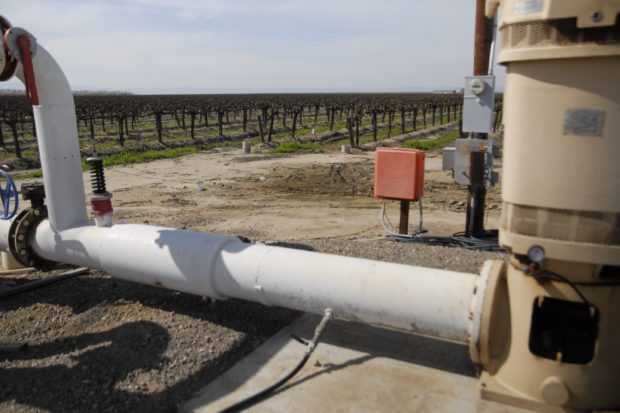
Aquifers in the Central Valley are being depleted at an ever-increasing rate according to a study recently published online by the prestigious Nature magazine. The research looked at two decades of data collected from on-the-ground measurements combined with remote sensing data gathered from satellite surveillance.
The stunning scientific paper documents an increasingly rapid rate at which groundwater has been lost over three drought periods during the 23-year megadrought currently afflicting the West and especially the San Joaquin Valley.
Groundwater accounts for nearly half the irrigation supplies for farms and cities in California’s Central Valley. When surface water is abundant, groundwater provides about one-third of the water used by the state’s farms and cities. But in times of drought, groundwater supplies two-thirds of the water consumed.
The region stretching from Redding to Bakersfield produces nearly 25% of the nation’s food. But the dramatic growth of permanent, water-thirsty orchards and vineyards is driving an increasingly precipitous decline in groundwater resources, especially during periods of drought.
The groundwater analysis combined measurements over the 20-year stretch of the current megadrought, from sources on the ground and data from NASA’s GRACE satellite project.
Jay Famiglietti was director of the Global Institute for Water Security at the University of Saskatchewan during the study period and a lead author of the research paper. He said that “it’s hard to overestimate the importance of groundwater. Without groundwater, we have no desert cities, we have a drastic reduction in food production and we lose our climate resilience.”
Gravity Recovery and Climate Experiment
GRACE stands for Gravity Recovery and Climate Experiment, a satellite experiment run by the Jet Propulsion Lab at CalTech. Using sophisticated detection tools, the satellite can measure the amount of groundwater loss or gain within millimeters.
Pang-Wei Liu is a NASA scientist and the other lead author of the investigation. He says that “the dataset has been long enough to provide some indicative findings and scientific findings in the groundwater from these two decades. We calculated the groundwater change from the remote data set.”
Liu matched satellite measurements to ground-based data. “Then we found that the (groundwater) depression keeps going on and that the depression rate is increasing in the past 10 years.”
Liu explains how the satellite data over a large area is analyzed to determine how much groundwater there is in the Central Valley and compare that over the 23-year time frame of the megadrought, “GRACE typically measures the gravity change of the earth.
“So conceptually, the gravity change can be related to the weight change of the earth. And the major weight change from the earth is the relocation of the water.
“From this, then we can measure the total water storage change on the earth. So, we compare with the well data and kind of confirm that this finding is correct.”
Data from NASA’s GRACE and subsequent GRACE-Follow On satellite missions over the past two decades were merged with groundwater measurements taken from gauging wells throughout the region along with data collected by public agencies such as California’s Department of Water Resources.
The GRACE satellites can measure the amount of water in reservoirs, stream flows, snowpack and surface moisture. All that information is analyzed to calculate changes in the amount of water in the Valley’s aquifers.
Groundwater depletion
Groundwater depletion was especially serious during three drought episodes over the past two decades. The first was 2006 to 2010, the second was 2011 to 2017 and the most recent was 2019 to 2021.
Each drought was followed by abundant precipitation and groundwater recharge. But in every instance increased pumping drove groundwater levels further down. Groundwater recharge couldn’t keep up with depletion.
In 2014, California finally created a plan to manage groundwater use in response to the crisis. Famiglietti confirms that their research findings played a key role in that decision.
“You know, we’ve been doing this work for a while. So, our message is out there. And I would say that it has been very impactful in California.
“The work that we did on our team helped take the conversation to the public and therefore then gave the Governor the political mandate to go ahead and move forward with the Sustainable Groundwater Management Act.”
After each drought episode researchers found abundant rain and deep snow helped recharge Central Valley aquifers. But not completely.
Throughout the drought periods, pumping continued and increased, pushing the water table ever lower. Groundwater would be partially replenished during wet interludes but then sink even further when pumping ramped up again during dry intervals.
Famiglietti says their research shows groundwater depletion has been mainly propelled by the rapidly expanding estates of perennial, water-devouring crops such as almonds, citrus and wine grapes.
“It is industrial-scale groundwater mining,” notes Famiglietti. “So even a really good winter is not enough. It hasn’t done it for a hundred years. It’s not going to do it. We’ll recharge our reservoirs. Things will look great on the surface.
“And, you know, even if we have a few good winters in a row, great. If not, three years from now it will just be doing this again.”
The numbers coming out of the research are staggering. Imagine what a cubic kilometer looks like if you’re standing next to one. Now imagine 44 cubic kilometers of water.
Megadrought
Over the past two decades of megadrought, the Central Valley consumed that much, nearly 36 million acre-feet of groundwater. That translates to 11.7 trillion gallons of our most precious resource. Almost one and a half times the capacity of Lake Meade, the nation’s largest reservoir.
Much of the groundwater depletion has occurred in the San Joaquin Valley. Kern County alone accounted for 40% of the loss over that time. In the most recent drought, from 2019 to 2021, researchers found aquifers are being depleted at an increasingly rapid rate, in fact 31% faster than in the previous two droughts.
Just in the past year more than 5,300 wells in the state have dried up. Most of those failed wells are in Madera, Fresno, Tulare and Kern counties.
Famiglietti, now a global futures professor at Arizona State University, is doubtful in an era of global warming and climate instability that atmospheric rivers alone will be sufficient to recharge the Valley’s aquifers.
“Deeper stuff. No, that’s never coming back. We’ve been doing this for a hundred years, and we get a little bit of replenishment. Most of that replenishment happens near the surface because it’s closer.
“So those are the aquifers that when we talk about managed aquifer recharge and replenishment, that’s the stuff that’s easier to recharge. But when you’re getting down to 2,500 feet, you’re not replenishing. That’s not coming back.
“That stuff took place in geologic time. Hundreds of thousands, millions of years ago. We’re burning through it in a century.”
“Water isn’t valued like oil, right?” Famiglietti queries, “and if it were, we’d be doing a much better job of using our water extremely carefully, of exploring the aquifers and knowing exactly how much is there and where it all is, and what’s the availability, and what are the timelines. But because it’s so undervalued, we haven’t really done that.”
Famiglietti concludes that stress on groundwater resources will only increase in a drying climate and depletion will likely continue without strong management intervention.
“You cannot manage what you don’t measure,” he says. “But if we’re not measuring every well or measuring groundwater use at the farm level, we’re in trouble. There’s always been resistance there. But you know, we’re past that point. We can have no more resistance.”

